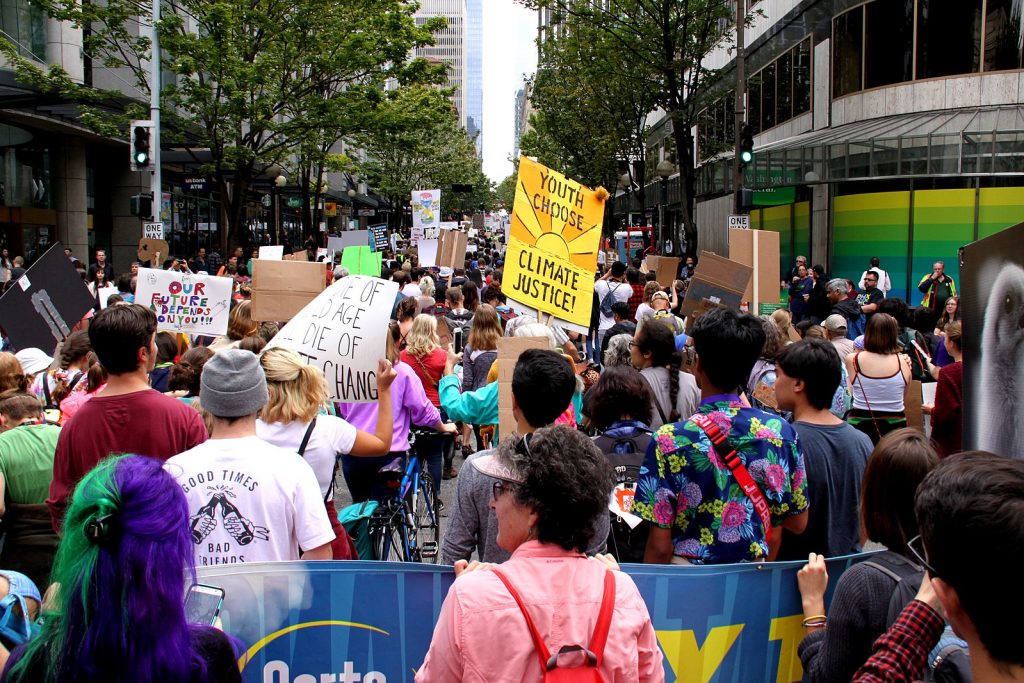15 Student Strikes and Walkouts
Micah Glasby
Student Walkouts for Climate Justice

Students walkouts for Climate Justice is a phenomenon that has only recently taken root. These new protests have garnered attention from the news and other media agencies both locally and nationally. They are different from other forms of protest because they are made expressly by a demographic which cannot vote, and thus has no legal means to effecting policy changes. In this particular case the desired policy changes are centered around climate change and social injustice. The goal of this report is to identify what the protestors do and do not want, and to provide the public with the tools to understand how to approach the conversation about climate justice with the youth.
Walkouts over the Years
While protests about climate change have been happening for decades, a recent surge in student walkouts for Climate Justice can be credited to one Ms. Greta Thunberg (Klein). In recent years she has enable the coordination of Global Climate Strikes, where students from all over the world march from their schools to demand that changes be made. As many as 1.4 million people have taken part in these protests, which shows that support is widespread, and that a large portion of the youth believe it is time for change (Carrington). It should be noted that in Seattle, every child that leaves the classroom is receiving an unexcused absence (Bush) . This policy, which does not directly prevent the students from striking, certainly does provide a risk and a hurdle to students who wish to join their peers in demanding change. Even in 2020, with all the COVID restrictions, the protests have continued, which further demonstrates how important students feel climate change is. Do not be mistaken, just because they are off the street does not mean they have gone away. The protesters are still around, though now they are using zoom and social media to demand change (Abnett). This does mean, however, that for now, as with many things, student walkouts have been halted. It is this writer’s opinion, though, that the public can expect the protests to resume right where they left off when it is again safe to do so. This also means that these students should not be approached as a fad or a faze, because their adaptation and resilience indicate a drive that will not simply disappear with time .
Desires and Demands
Students are clearly willing to protest, but their demands can seem far less clear. In recent times a few demands have risen above the cacophony of different demands. The first demand is so nicely put in the concerns of a student named Lilah Amon-Lucas, “My life expectancy could be shortened because of how rapidly the climate is warming. I need to think about whether it makes sense to have kids” (Bush). The decision to have kids is one this is not far in the future. It is a decision many adults have considered, and so for the youth to be hesitant because of climate change shows just how pressing students feel the issue is. The other major demand is finely put by Hsieh, a Seattle student, “No one should be apologizing. Show us with your actions” (Sengupta). This statement really sums up Seattle students desire not for more talk, but for action by policy makes and influential leaders. These students have also embraced the Climate Justice movement with signs reading “Green New Deal, make it real,” and carrying signs that read “The sea is rising, so must we” and they are demanding that the voices of the underrepresented be heard (Sengupta). These are lofty goals, but these students also are making more tangible demands, like for companies and politicians to stop supporting fossil fuels (Sengupta). At the end of the day, these students want to see carbon dioxide levels go down, and they want to see quality of life improved for everyone, everywhere.
Results
With so many students from so many places around the worlds making so many requests, it can be difficult to sort out if they have achieved any results. While the following achievements may not be directly tied to the student walkouts for Climate Justice, they do demonstrate that changes are being made. Strikers at Amazon demanded that the company go to being carbon-neutral, and Amazon CEO Jeff Bezos responded by committing to employing 100,000 electric delivery vans that will start delivering packages in 2021 ( King 5 Staff “Washington Students”). The European Union and China have also officially committed to being carbon neutral (Abnett). The future remains uncertain, and these victories are not the fulfillment of all the demands of the protesters, but they are signs that the protests may be working.
In Summary
At the end of the day, these students want change. They are willing to risk COVID and unexcused absences to make their claim, as they walk out of their classrooms and gather together in demonstration to demand climate justice. They want to see carbon dioxide levels fall. They want to politicians and companies to stop investing in fossil fuels. They want a future with a higher quality of life for all, and they have seen some successes. Mainly, they want to have their concerns heard, and more than anything they want their elders to take action.
Media Attributions
- 1599px-Seattle_Climate_Rally_(48766671928) © Spencer Thomas is licensed under a CC BY (Attribution) license

